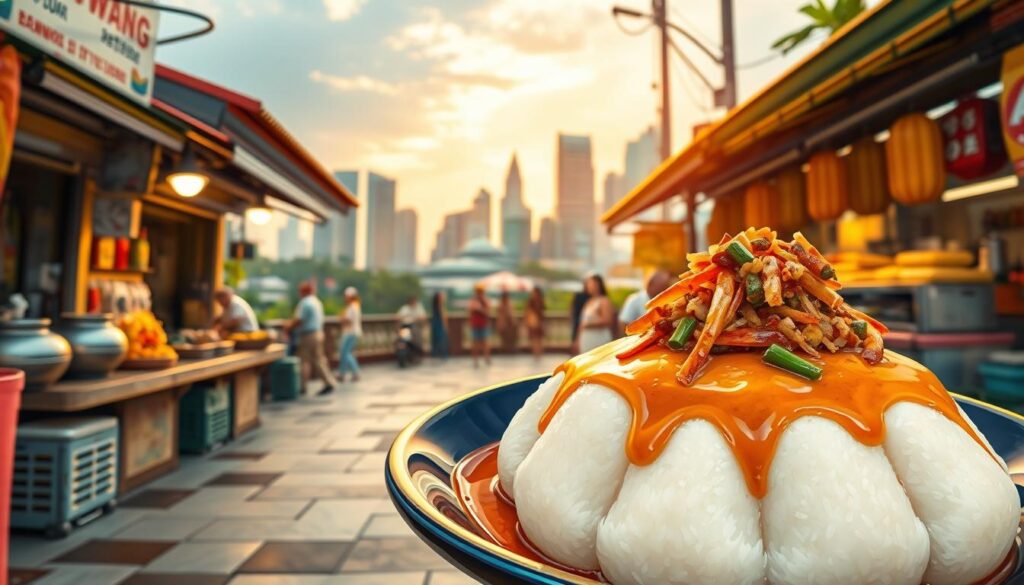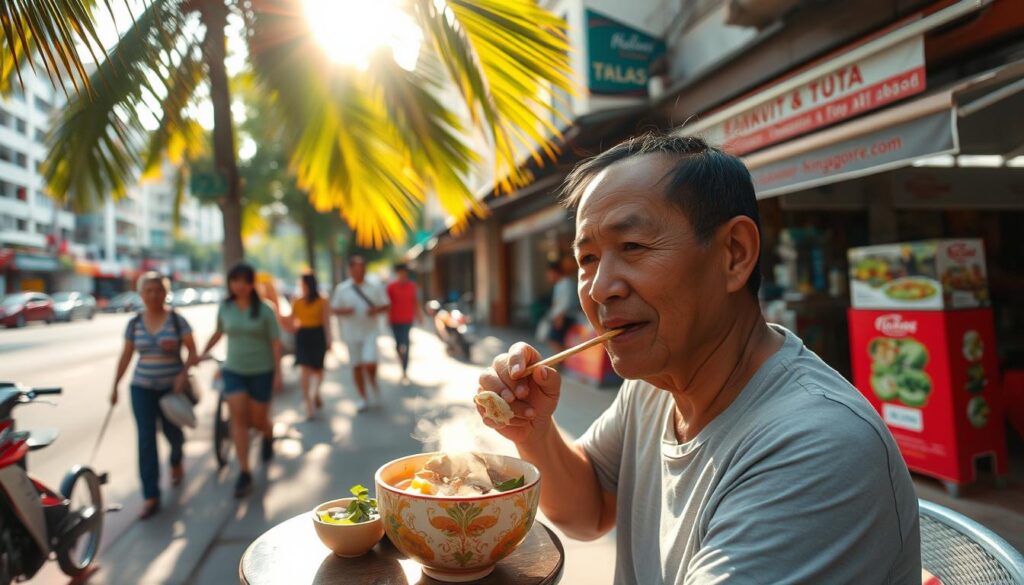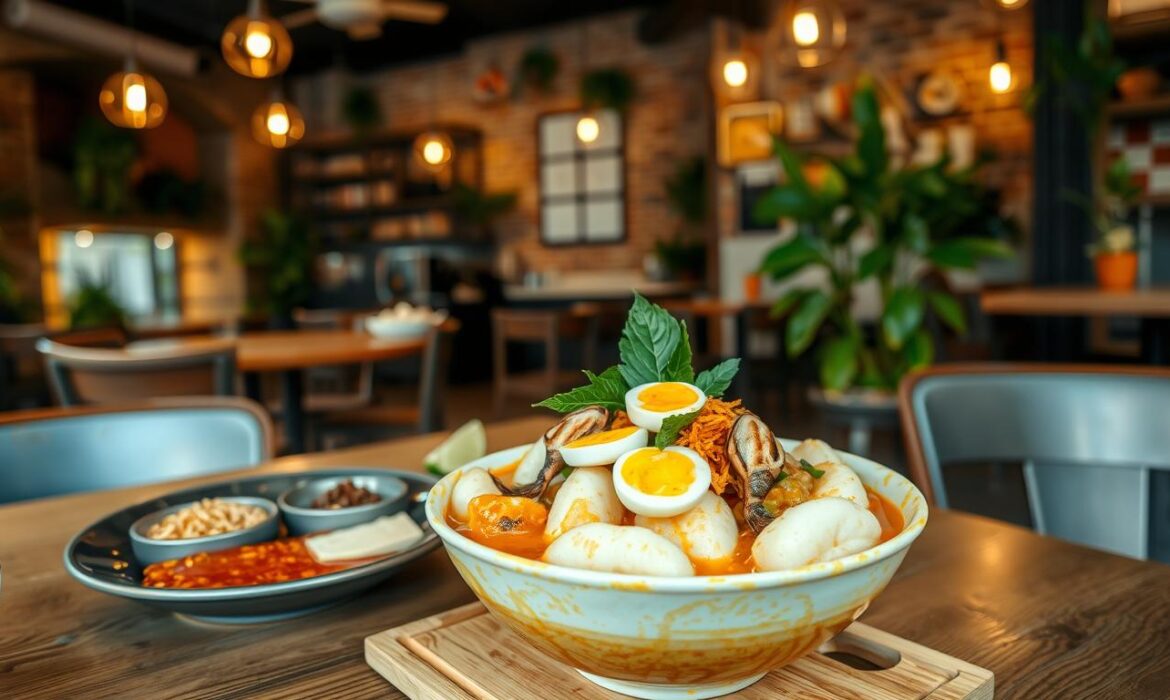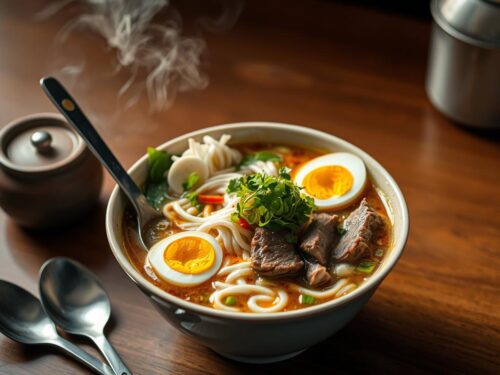Few dishes capture the essence of Singaporean comfort food like lontong. This fragrant meal features compressed rice cakes soaked in a light coconut curry, topped with savory serunding and spicy sambal. What seems simple at first glance reveals layers of balanced flavors.
Locals cherish this dish as both a breakfast staple and anytime comfort food. The combination of soft rice cubes, crunchy vegetables, and firm tofu creates a satisfying texture contrast. Each component plays a vital role in the overall experience.
Across the island, chefs put their unique spin on this traditional favorite. From hawker stalls to family-run eateries, the variations showcase Singapore’s diverse culinary creativity. This guide explores ten standout versions worth discovering.
Key Takeaways
- Features compressed rice cakes in aromatic coconut broth
- Balances sweet, spicy, and umami flavors perfectly
- Served with vegetables, tofu, and flavorful toppings
- Considered both breakfast food and comfort dish
- Available at hawker centers and specialty shops islandwide
What Makes Lontong Special in Singapore?
The magic of this dish lies in its perfect harmony of textures and flavors. Soft rice cakes soak up a fragrant coconut broth, while crunchy vegetables and fried tofu add contrast. Each component plays a vital role.
- Rice cakes: Steamed and compressed for a chewy bite.
- Vegetable curry: Light yet flavorful, with spices like turmeric and lemongrass.
- Serunding: Toasted shredded coconut with chili and galangal.
- Sambal: A fiery chili paste that ties everything together.
Families guard their recipes closely, often passed down for decades. Malay and Peranakan versions differ slightly—some use richer broths, others add boiled eggs.
During festivals, it’s served communally, symbolizing unity. Unlike ketupat or nasi lemak, this dish relies on broth to meld flavors.
Pro tip: Eat it fresh to enjoy the rice cakes before they soften too much. Perfect for breakfast or a hearty snack.
Where to Find the Best Lontong in Singapore
From humble stalls to cozy cafes, these eateries elevate traditional flavors with their signature twists. Whether you crave a sweet broth or fiery sambal, there’s a spot for every preference.

Queenstown Lontong: A Sweet Legacy
This decades-old stall charms with a slightly sweet coconut broth. Their rice cakes stay firm, paired with tender jackfruit and crispy serunding.
Hassan Stall: A Family Affair
Run by three generations, Hassan’s version features a robust broth simmered with galangal. Ask for extra fried tofu—it’s legendary.
Delicious 美味: A CBD Hidden Gem
Tucked in a bustling food court, their lontong comes with a side of nasi padang toppings. Perfect for a hearty lunch.
Java Corner: Umami-Rich Lontong
Their broth packs a punch with dried shrimp and turmeric. Pro tip: Add a spoonful of their house-made chili paste.
Afghanistan Family Restaurant: A Hearty Institution
Known for generous portions, this Whampoa spot includes boiled eggs and tempeh. Arrive by 3 PM before they sell out.
Kampong Glam Cafe: Heritage Flavors
Near Sultan Mosque, their recipe uses a lemongrass-infused broth. The blue signboard at Kim Keat House is hard to miss.
Chai Chee Nasi Lemak: Two Ways to Enjoy
Order it dry or with broth—both versions shine. Their sambal balances heat and sweetness perfectly.
Mukmin Restaurant: A Family Favorite
Regulars swear by their tender beef rendang topping. Portions are customizable, ideal for sharing.
Nusa & Tara: A Lunchtime Must-Try
Their broth is lighter, letting the vegetables shine. Pair with a side of otak-otak for extra flavor.
Warung Wahyu: A Hidden Treasure
This stall near Geylang serves a rich, spice-forward version. Cash only, so come prepared.
- Neighborhood gems: Explore areas like Whampoa for lesser-known stalls.
- Customize: Many spots let you adjust spice levels or add toppings.
- Timing: Late afternoon visits avoid crowds but check closing hours.
Tips for Enjoying Lontong Like a Local
Eating this dish like a true Singaporean involves mastering a few simple tricks. From timing to toppings, small adjustments elevate the experience.

Timing Is Everything
Ideal for breakfast or late lunch, this dish shines when fresh. Stalls like Afghanistan Family Restaurant open early, serving steaming bowls by 7 AM. For lunch, arrive before crowds peak—around 11:30 AM.
Sambal Savvy
Locals drizzle sambal gradually to control heat. Java Corner lets you customize spice levels. Start with a teaspoon, then add more as needed.
Sharing Strategies
Mukmin Restaurant’s family-sized portions are perfect for groups. Split a large bowl and order extra toppings like serunding or fried tofu.
| Drink Pairing | Why It Works |
|---|---|
| Teh tarik | Balances spicy sambal with creamy sweetness. |
| Coffee | Cut through the coconut broth’s richness. |
Leftover Tips
Store broth and rice cakes separately. Reheat gently to avoid mushiness. Add fresh veggies for crunch.
With these tips, even first-timers can dine like locals. Whether with families or solo, every bite becomes memorable.
Conclusion
A bowl of warm coconut broth and rice cakes is more than just a food—it’s tradition. This dish reflects Singapore’s vibrant hawker culture, blending heritage with everyday comfort.
Don’t settle for just one version. Explore both classic and modern takes to appreciate its full range. Pro tip: Compare stalls to discover subtle regional twists.
Have a favorite spot? Share it with fellow enthusiasts to keep the tradition alive. Let’s celebrate and preserve these iconic dishes for generations.



